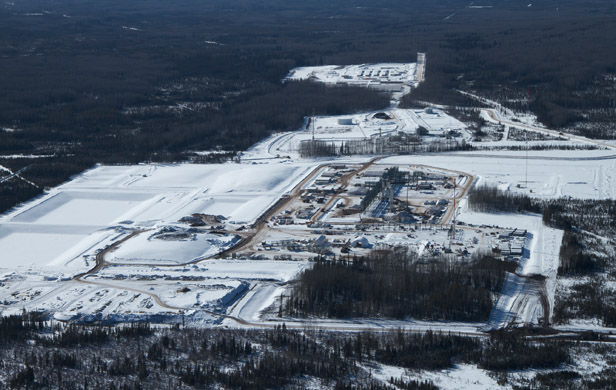
Beneath the glowing rhetoric surrounding BC’s promised liquefied natural gas (LNG) boom lies a dirty little secret: the vast majority of the industry would be powered by controversial fracking in northeast BC. Add that to the huge carbon footprint and local air pollution from the plants themselves and “clean” LNG becomes an oxymoron of epic proportions.
Dirty fracking
The relatively new technique of fracking involves hoovering up enormous volumes of water out of lakes and rivers, injecting it with fine sand and largely unknown, toxic chemicals, then blasting this cocktail deep underground to crack open shale formations where gases are “trapped” (as if they’re just begging to be freed!).
[quote]Every time you hear LNG, think of one of the least efficient energy systems every invented. Think fracking. Think water contamination. Think asthma. Think climate change…[/quote]
This “game-changing” combination of technologies has, in the decade or so that it has been in widespread use, provoked a wave protests, bans and moratoriums around the world, over its impacts on air, water, and human health.
In touting the economic potential of LNG terminals on BC’s coast – of which a dozen or so have been proposed, along with four major pipelines to supply them with gas from northeast BC and Alberta – the BC Liberal Government ignores the fact that they would be powered by what shale gas expert David Hughes calls “a very aggressive increase in the number of fracked wells in northeast BC”.
LNG = Way, way more fracking
Today, BC produces about 4 billion cubic feet a day of natural gas. It has taken us 50 years and 39,000 wells to get to this point.

The consequences are evident whenever you fly over the Peace Valley region near Fort St. John, or the Horn River Basin, northeast of Fort Nelson. Geometrical patterns of well pads, industrial roads, seismic lines, processing plants, compressor stations and massive water pits carve up the northern Boreal landscape as far as the eye can see.
It’s hard to imagine what a several-fold increase in all this activity would look like, but that’s precisely what would be required to power BC’s LNG industry.
Presently, a little under half the gas coming out of BC is from fracking – the rest from “conventional” gas plays. But that balance is quickly shifting. We’ve already tapped most of the easy, lower-impact stuff and the majority of new supplies will come from shale gas.
BC’s Minister of Natural Gas Development, Rich Coleman, recently revealed the extent of his government’s vision for “clean” LNG: they want to see five of these plants built, with three up and running by 2020.
If you look at the volumes of the four pipelines proposed to supply these plants – two to Kitimat, the other two to Prince Rupert – the combined capacity ranges from 10-15 billion cubic feet/day (2.5 to almost 4 times our current production).
Minister Coleman intends to continue supplying BC’s own energy needs and our Canadian and US customers – this new LNG would come on top of that 4 billion cubic feet/day.
That means a several-fold increase in gas production into the distant future. Since most of that new supply would have to come from fracking, you can see why a massive increase would be required to feed LNG.
The impacts would extend in many directions. The 11 billion or so litres of water reported by the Oil and Gas Commission as used and contaminated for fracking each year in BC would be upped several-fold – this in a region often beset by drought conditions. The potential health impacts (only now being investigated by the BC government) from flaring, escaped methane and even more toxic gases would also be ramped up accordingly.
See timelapse animation of increasing water withdrawals for fracking in the Horn River Basin (story continues below).
Fracked-up economics
Fracking has been a victim of its own success. While it has opened up new supplies of previously inaccessible gas, the combination of this new technology and reduced royalties from governments like BC’s to incentivize development has seen the North American market flooded with gas.
The result has been tremendous downward pressure on domestic prices. A resource that once fetched $8-plus per unit, is now routinely below $4, sometimes much worse. But in Asia, prices have remained high – upwards of four or five times the local price. So the big idea is for North American producers to access these markets and capture higher returns. (I won’t touch the reams of evidence undermining this model here – we’ll cover that in the next piece in this series).
Climate and air pollution
The problem is that in order to carry the gas to these overseas markets, it has to be cooled to minus 160 degrees celsius, and that takes enormous amounts of energy – far more than we can supply with our public electricity system (though the BC government wants to flood a 100km section of the Peace River to build a dam that would help power LNG plants through taxpayer-subsidized pubic energy).
So a government that just a few years back brought in a “Clean Energy Act” with much fanfare is now back-pedalling, allowing the industry to use its own gas to create electricity to cool and liquefy the gas. The result would be a massive increase in BC’s carbon emissions.
More than that, local residents in Kitimat and Prince Rupert could see dangerous increases in air pollution. The BC government only recently announced a study into air pollution from three proposed Kitimat plants for local residents. With the modernization of Alcan’s Kitimat aluminium smelter set to double its SO2 output, even a government bullish on LNG is compelled to consider what these new LNG plants would mean for public health.
Yet an air pollution expert from the University of British Columbia, Prof. Douw Steyn, feels the $650,000 budget and six month timeframe for the study is woefully inadequate. I can understand why they want it. “The big question is: ‘Is that timeline being driven by the cause of industry or by prudent science,'” Steyn asked upon the study’s announcement last week.
Moreover, why weren’t these studies carried out before the government staked BC’s economic future on an LNG boom?
BC’s low standards
A recent study by Clean Energy Canada found that even if we’re to ignore the dirty source of BC’s LNG (fracking), the cooling process itself would be far dirtier per unit of energy produced than comparable operations in places like Australia and Norway – further putting the lie to Coleman and co.’s “world’s cleanest LNG” boasts.
In reality, BC’s LNG industry would have a profound impact on the province’s carbon footprint – a highly irresponsible economic model at the very time the world’s top scientists are reminding us of the effects of man-made climate change. While other industrialized nations are reaping the benefits of a boom in renewable energy development and building a green economy, Canada is still hellbent on old-world, fossil fuel economics.
LNG’s inefficiency
In closing, let me describe, in a nutshell, BC’s economic vision, if this LNG scheme proceeds as planned:
We will take tens of billions of litres of water out of our rivers and lakes, inject them full of chemicals, then use enormous amounts of energy to blast this concoction underground and recover gas. More energy will then used to clean and process the gas, before it’s piped 800 km across northern BC, powered by more, energy-intensive compressor stations along the way.
Then, even more gas and electricity will be consumed in massive quantities to cool the gas, which will be loaded onto ships whose trans-Pacific voyage is powered by even more gas. Meanwhile, another ship carries our raw logs and metals to a factory in China, where our gas is burned so those raw materials can be manufactured into finished goods, which are then put on a ship, fuelled by bunker diesel, on its way back to Canada.
All so those goods can be trucked to a Walmart, where we can drive our cars to save a few bucks on a cheap table that ends up in the landfill a few years later.
That’s the future BC’s politicians are trying desperately to build. There is nothing “clean” or visionary about it.
So every time you hear LNG, think of one of the least efficient energy systems every invented. Think fracking. Think water contamination. Think asthma. Think climate change…
Whatever you do, don’t think “clean”.


Thank you for posting this, i was watching the news and always keep hearing talk of “lng lng” “its so clean”
after watching the david suzuki fracking documentary a year ago, I had this thought like wait a minute, isnt this whole liquified natural gas coming from fracking? I couldnt remember exactly what it was they were fracking for, but I thought it was LNG. So I tryed to look it up, absolutely every source from the government avoids the term fracking and any sort of talk about it and how its actually damaging to extract this ‘clean’ energy from the ground. I had already heard about fracking and just wanted a refresher, imagine people who aren’t very aware (which lets face it is a lot) and how impossible it would be for them to know the truth.
Well, you’ve come to the right place, r – home of the best independent coverage of the LNG issue around.
I urge you to check out our more recent stories in our LNG section:
https://commonsensecanadian.ca/category/energy-2/lng/
We’ll continue to keep Canadians informed on the real implications of this industry for our economy and environment.
Thank you so much Damien (Caleb and Fractured Land team) for continuing to provide us with food (land, air and WATER) for thought!
I have noticed that the more that LNG gets pushed to the top of the provincial economic agenda, the less we seem to hear about ‘fracking’ … and the mention of WATER is virtually absent!
With Squamish in the early stages of a proposed LNG facility, your insight in the context of the ‘big picture’ will be valuable and an important part of our community dialogue.
So THANK YOU for taking the LNG conversation further upstream to it headwaters!
“largely unknown, toxic chemicals”
Really? You’re just gunna put that in there in the first paragraph and not elaborate?
That’s right, Guy. Kind of the whole issue with them being “largely unknown”!
In any event, here’s some more reading for you on the subject, since you asked. From The Guardian: “Fracking in America generated 280bn US gallons of toxic waste water last year – enough to flood all of Washington DC beneath a 22ft deep toxic lagoon, a new report out on Thursday found.”
http://www.theguardian.com/environment/2013/oct/04/fracking-us-toxic-waste-water-washington
Thank you for the replied article. I hope to get to reading it asap.
Having sound facts in an discussion make it credible. Not only from a journalistic perspective, but a concerned citizens too. I imagine a lot of people get news from this site or ones like it.
Without proper citation misinformed environmentalist and citizens blurt out unsupported arguments. This leads to redundant arguments from both the left and the right, which aren’t constructive.
Obviously, I could have looked it up on my own, but such an important fact should be cited. This weekend I attended Powershift BC, and there I saw people so far to the left, and jaded, that their participation was counterproductive to the discussion.
So, with better information I can take a strong stand against such issues (fracking).